Reserve Bank of Australia Annual Report – 1983 Financial Intermediation
Financing
There were some marked changes in patterns of financing in 1982/83. Notably, there was a big increase in demands on financial markets by the public sector, especially the Commonwealth Government. This contributed to a very large rise in holdings by the private sector of liquid assets and Commonwealth Government securities (LGS). In contrast, the growth of private demand for credit weakened markedly and resulted in slower growth of broad measures of borrowing and lending by financial intermediaries; as well, raisings in private capital markets were, for most of the year, subdued. At the close of the year some signs of an upturn in demand for finance were becoming evident. The various demands and supplies for funds were matched at interest rates which, at least in nominal terms, fell during 1982/83.
These broad developments are described in more detail in the following paragraphs.
Private holdings of LGS increased by $6,000 million or by about 22 per cent in 1982/83. This was a much bigger rise than in any previous year and was due to the record deficit in the Commonwealth's budget and the large surplus on foreign exchange transactions. Graph 1 on page 11 shows the path of LGS through the year.
Despite the much stronger rise in LGS, most measures of borrowing and lending by financial intermediaries grew less rapidly in 1982/83 than in the year before. This contrast reflected the fact that a high proportion of the increase in LGS was taken up by households in the form of Australian Savings Bonds (ASB's) and by insurance companies, superannuation funds etc.
The table below summarises growth rates for borrowings and advances by financial intermediaries. An exception to the generally lower outcomes in 1982/83 was the banks which, because of a strong increase in deposits with the savings banks, grew more rapidly than in the year before. Results for the various groups of financial institutions are described in the section commencing on page 22.
| 1979 | 1980 | 1981 | 1982 | 1983 | |
|---|---|---|---|---|---|
| Deposits with banks | 11.8 | 12.4 | 12.7 | 11.3 | 12.9 |
| Borrowings by non-bank financial institutions(b) | 18.7 | 18.4 | 18.8 | 18.2 | 10½(e) |
| Borrowings by all financial institutions(c) | 14.7 | 14.0 | 15.9 | 14.0 | 11 (e) |
| Advances outstanding of all financial institutions(c) | 15.6 | 16.2 | 17.6 | 15.9 | 10½(e) |
| (a) Adjusted for breaks in series (b) Corporations, with assets over $5 million, registered under the Financial Corporations Act (c) Banks plus corporations under (b) (e) Estimate |
|||||
Looking at other forms of private financing, the amounts of new equity issues by companies were for most of 1982/83 below comparable figures in the previous year. Issues of, and trading in, corporate debentures were also subdued.
Activity in the share market was generally quiet in 1982/83. However, despite the declining state of the economy, share prices tended to rise during the year, affected in part by falls in interest rates. The “all ordinaries” index (with prices at end 1979 equal to 500) averaged 461 in July 1982, 510 in March 1983 and 604 in June 1983.
Turning to the public sector, the Commonwealth's budget deficit in 1982/83 was $4,472 million, much higher than the projection of $1,674 million in the Budget Speech and the outcome of $549 million in 1981/82. The manner in which this deficit was financed is illustrated in Graph 4. Net borrowing abroad came to $586 million. Of domestic financing in 1982/83, a proportion much higher than in recent years was in bonds; substantial amounts of Treasury bonds were put to tender and, in contrast with recent years, ASB's had competitive rates of interest for a good part of the time and attracted heavy net subscriptions.
With strong sales of securities direct to the private sector the Commonwealth had less need to rely on finance from the Bank by way of Treasury bills. At the end of the year the Bank held no Treasury bills.
| Announced | Currency | Net Proceeds |
|---|---|---|
| ($Am) | ||
| 23 June 1982 | Yen | 78 |
| 19 July | Sterling | 173 |
| 2 September | United States dollars | 415 |
| 17 September | Yen | 58 |
| 17 September | Deutschemarks | 82 |
| 4 November | Deutschemarks | 84 |
| 8 November | Guilders | 76 |
| 2 December | Guilders | 77 |
| 14 April 1983 | Yen | 92 |
Borrowing by local and semi-governmental authorities in 1982/83 was also much larger than in previous years. Electricity authorities borrowed $2,815 million (compared with $1,405 million in 1981/82), while borrowing by other authorities was $2,454 million ($2,077 million in 1981/82). Of total borrowing by these authorities, $416 million was raised abroad by semi-governmental bodies.
The total borrowing requirement of the public sector in 1982/83 was about $12 billion, equivalent to 7½ per cent of Australia's gross domestic product. This was more than double the comparable proportion in 1981/82.
4. Financing the Commonwealth Budget Deficit

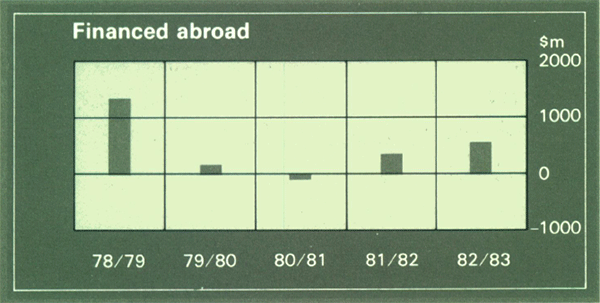


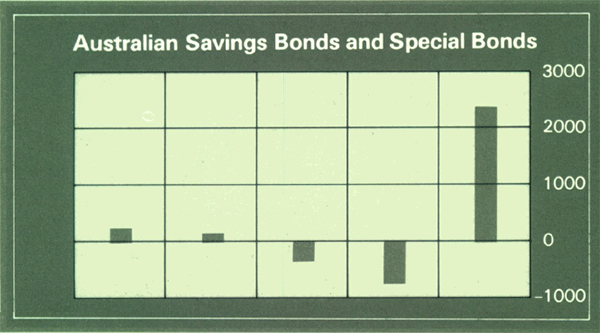
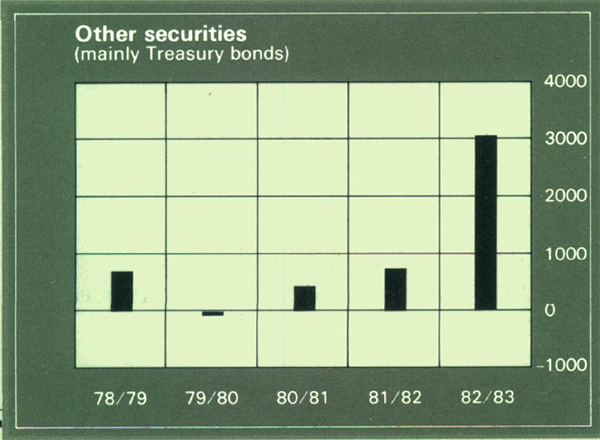
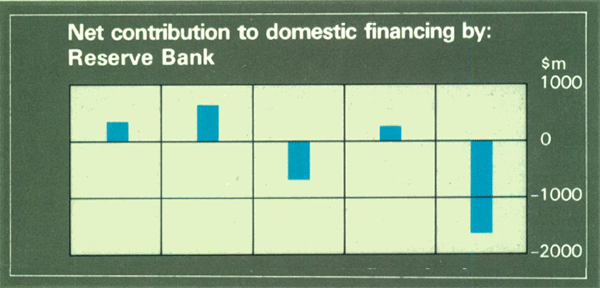
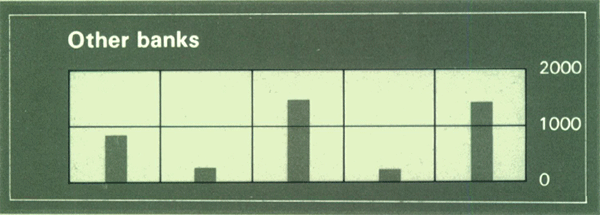
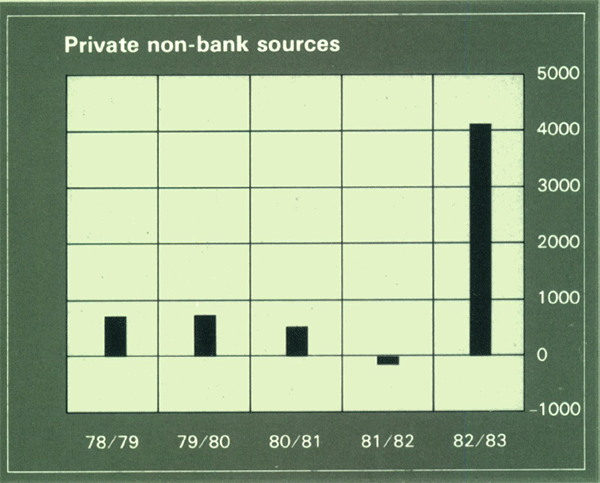
Intermediaries
Financial intermediaries during 1982/83 were adapting to changes in regulations, to shifts in the pattern and level of demand for finance and to innovations in available techniques. Growth in the balance sheets of groups mainly catering for the corporate sector was subdued in comparison with results for recent years; intermediaries dealing mainly with the household sector fared better. M3 – consisting mainly of bank deposits – grew by 12.5 per cent during the year; its average level was 11.1 per cent higher than in 1981/82.
In recent years moves have been made which reduced the burden of regulation on the banks. These have included removing controls over interest rates on bank deposits, easing restrictions on the maturity structure of those deposits and discontinuing quantitative guidance on lending by trading banks. During 1982/83, regulations affecting savings banks were eased. (See page 26)
Such changes, along with the general slowing in demand for financial intermediation, have contributed to a more competitive environment in financial markets and intermediaries responded in various ways during 1982/83. Some, especially savings banks, permanent building societies and credit unions, developed new and generally higher-yielding deposit packages. This, in turn, raised the effective cost of funds to these intermediaries and tended to reduce their margins. Intermediaries increased the range of ancillary services offered: for example, banks and building societies expanded the number of automated telling machines in service, and many intermediaries increased their range of plastic card, bill-paying, insurance and travel services.
Two mergers involving four major trading banks were completed. Through amalgamation or merger, the number of building societies (with assets in excess of $1 million) was reduced during the year from 99 to 80. There were other changes effected or proposed in shareholdings of financial intermediaries for purposes of rationalising ownership. Several new money market corporations were set up, some specialising in financial advisory services.
During the year eight foreign banks were granted permission to open representative offices in Australia. At end June 1983, 99 foreign banks had representative offices in Australia.
The Treasurer announced in May the establishment of a group to report on the financial system, having regard to the Campbell Committee's recommendations and taking account of the Government's economic and social objectives as well as the need to improve the efficiency of the financial system. In the meantime, he said, the Government would not proceed with the previous Government's policy on foreign bank entry; that Government had invited foreign interests to apply for banking licences, of which it envisaged making around ten available. The Treasurer also said that, once the report had been considered, the Government would be prepared to give careful consideration to applications for a banking authority from Australian interests which could meet the required prudential standards and other requirements of banking policy.
The following paragraphs describe briefly the experience of the major groups of financial intermediaries during 1982/83.
Deposits with the major trading banks grew by just over 7 per cent, half the average rate of increase in the previous four years. Loans, advances and bills discounted rose by about 8 per cent. The weaker demand for advances was reflected in falls in usage of overdraft limits during the year; this trend was interrupted by a sharp increase near the time of the devaluation when borrowers replaced foreign with domestic borrowings.
5. Indicators of Financial Conditions

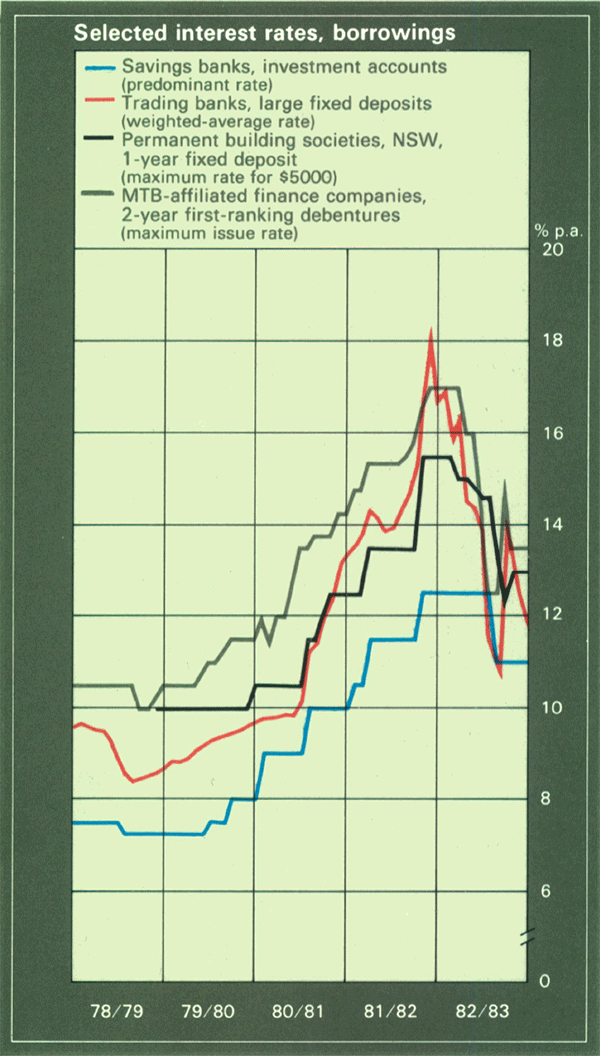
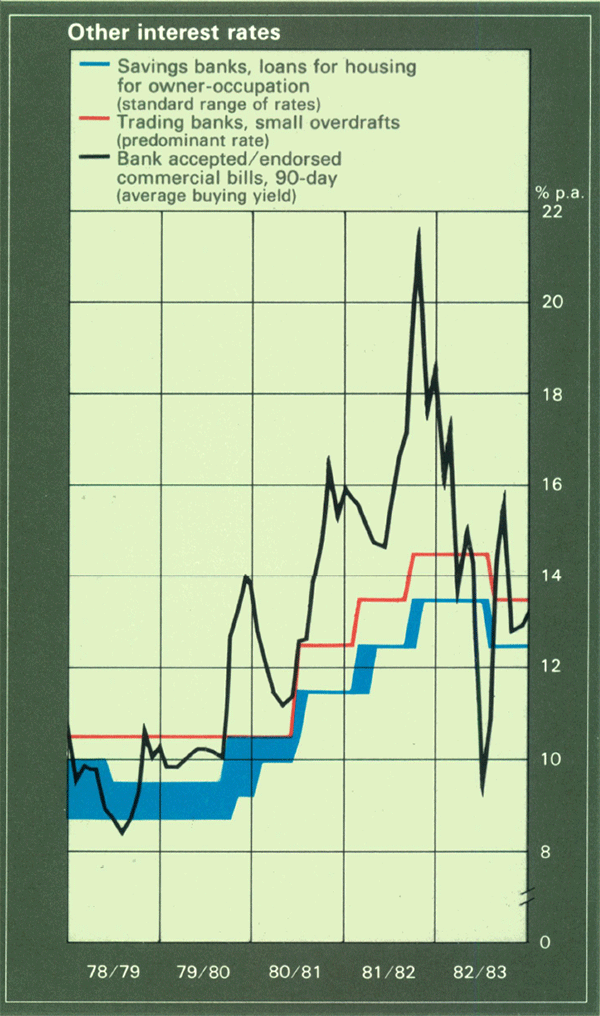
With only modest growth in the demand for advances, trading banks generally reduced their interest rates over 1982/83. However, as a consequence of extreme volatility in the cost of short-term funds, rates offered and paid by banks were also unusually volatile. They were generally at their lowest around January/February.
The LGS ratio of the major trading banks was low in the early months of the year. It increased in the December quarter and was generally above the level in the corresponding months of the previous year. Early in 1983 the banks allowed the LGS ratio to decline and in late February/early March, when funds were leaving the country, their LGS in excess of the 18 per cent convention fell to very low levels. After the devaluation, the banks moved quickly to rebuild their LGS and, as a result, were comfortably placed to cope with the payment of taxes in April and the first half of May. Subsequently, when financial conditions tightened briefly the banks, to provide cover against possible end-year stringency in markets, bid strongly for funds. For the June quarter as a whole their LGS ratio averaged around 19 per cent. The SRD ratio for the major trading banks was 7 per cent throughout 1982/83. The rate of interest paid on these deposits was 5 per cent per annum.
Other trading banks also had a much reduced increase in their deposits during 1982/83 – just under 11 per cent, compared with the rise of 20 per cent in the year before.
Increases in bill limits from all trading banks were smaller in 1982/83 than in 1981/82, but the usage rate increased. Consequently, the value of bank bills outstanding grew by 35 per cent in 1982/83, not much below the increase of 38 per cent the year before. The lower cost of bill financing, compared with rates on other loans, for much of the year made this attractive for borrowers.
In contrast with most other groups, savings banks recorded rapid growth in 1982/83; the increase of almost 20 per cent in their deposits was more than double the average rise in the previous four years. This acceleration reflected importantly an improvement around mid year in their competitive position when interest rates available on alternative investments – such as deposits with trading banks and cash management trusts – fell in advance of reductions in rates offered by the savings banks. A little earlier the position of savings banks had been enhanced by the changes in regulations affecting them; apart from permitting them to raise the proportion of their assets in advances for housing, these changes allowed the banks to accept deposits in limited amounts from commercial organisations and to invest some of their deposits as they wished. As well, early in 1982 the provision for one month's notice on withdrawal from savings banks' investment accounts had been removed; the proportion of their deposits in investment accounts and deposit stock rose from 45.5 per cent in June 1982 to 52 per cent in June 1983. Growth in deposits with savings banks slowed somewhat after they made reductions in their interest rates in February 1983.
The rate of growth in savings banks' advances for housing was less than that in their deposits, but was still much greater than in the previous couple of years. Savings banks' approvals of loans for housing began to rise early in the year and for 1982/83 came to over $3½ billion, by far the largest annual result yet. In March 1982 the nationally operating banks had given an undertaking to the Government, in response to certain measures to be taken by the Government, that they would raise their new lending for housing by $400 million over the following twelve months. In November they gave an undertaking to maintain, at least, the resulting level of lending for a further twelve months.
6. Advances Outstanding
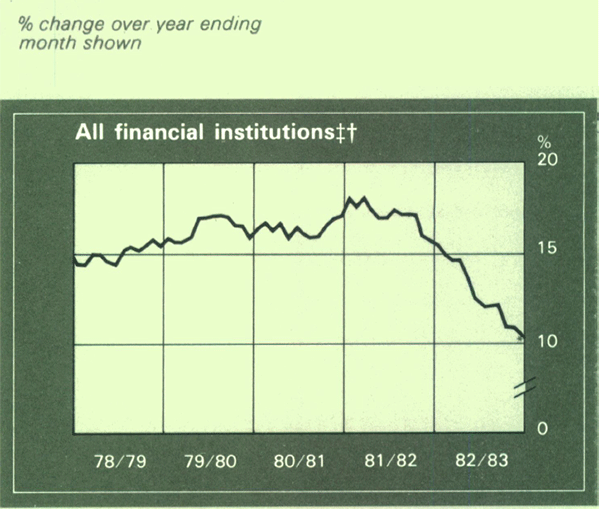
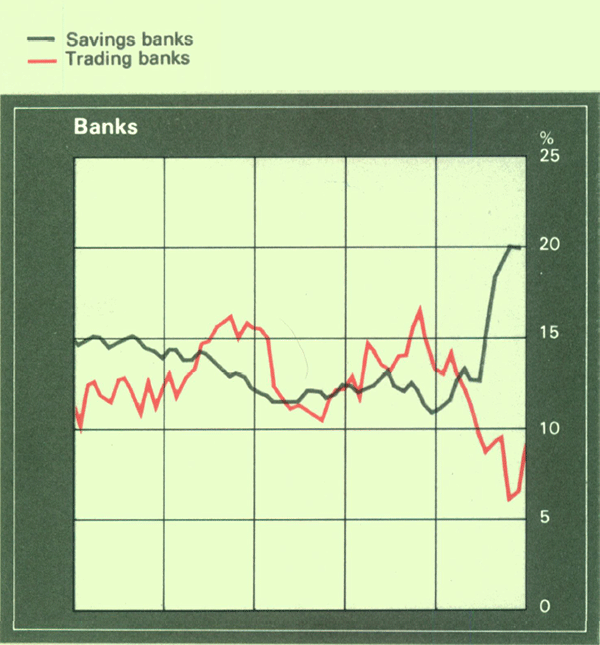
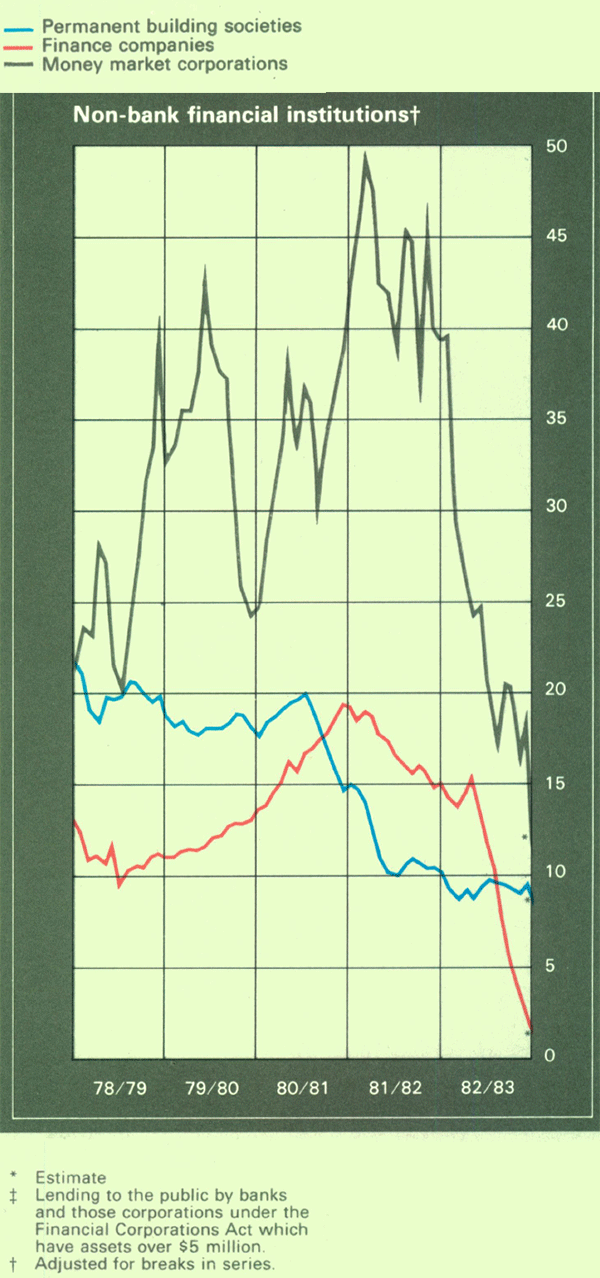
Changes to Regulations for Savings Banks
On 26 August the Treasurer announced amendments to the Banking (Savings Banks) Regulations. Briefly, the amended regulations:
- require each savings bank to invest a minimum of 15 per cent of depositors' balances in cash, deposits with the Bank and Commonwealth Government securities (the amendments were effective from 31 August, but for a transitional period to 30 June 1983 banks had the option of observing this or the previous 7½ per cent requirement);
- allow the banks to invest 6 per cent of deposits in assets – other than fixed assets – of their choice;
- restrict their other investments mainly to public sector securities and loans secured on land in Australia.
The amendments also relaxed restrictions on sources of deposits to allow savings banks to accept deposits from trading or profit-making bodies up to a maximum, for each entity, of $100,000.
The savings banks were at times during 1982/83 very liquid as a result of the exceptionally fast growth in deposits. At the end of the year the proportion of their assets in LGS was higher than at the start.
Borrowings by the other major lenders for housing – permanent building societies – increased by about 12 per cent in 1982/83. This was faster than in the previous couple of years, although much slower than in the years before that. As with savings banks, the societies' interest rates had been constrained while market-determined rates were rising from 1980. When market rates came down in the first half of 1982/83, societies were slower to reduce their borrowing rates and, for a time, their ability to attract funds increased.
Societies increased their loans outstanding for housing by much less than the rate at which their available funds increased. To some extent, this reflected weaker demand for such loans; also, it was unprofitable for societies to lend for housing those funds which they had attracted in accounts on which they paid rates of interest comparable with rates in short-term money markets. At June 1983, societies' loans for housing represented about 71 per cent of their borrowings from the public; this compared with 78 per cent a year earlier.
Finance companies grew slowly in the past year, with borrowings from the public increasing by only about 3 per cent; this compared with a rise of about 13 per cent in 1981/82. Finance companies attracted strong inflows of funds early in the year, but, with demand for loans falling, they then for a time restricted subscriptions to their issues or withdrew from the market altogether. The level of their borrowings dropped sharply in the middle months of the year.
Reflecting the subdued corporate demand for funds, there was also a substantial slowing in the expansion of money market corporations in 1982/83. Their borrowings from the public had increased by almost 40 per cent in 1981/82; in the twelve months to December 1982, growth was 19 per cent; over the twelve months to June 1983 it was down to about 15 per cent.
Cash management trusts, which had expanded rapidly during 1981/82, continued to grow in the early months of the past year while short-term interest rates stayed high. After August, however, deposits with the trusts showed little net change; this coincided with the fall to a lower average level in yields on commercial bills, the trusts' main assets. In June 1983, 16 trusts held funds of about $2,190 million, compared with deposits of about $1,650 million held by 13 trusts in June 1982.
Supervision of banks
Last year's Report contained an outline of the Bank's general approach to supervision of banks. The prime responsibility for the prudent management of a bank's business, of course, lies with the bank itself. The Bank aims to satisfy itself that a bank's prudential standards are adequate, and that those standards are kept under review to take account of changing circumstances. The Bank itself does not physically inspect the books of banks but it obtains a large volume of statistical and other material from banks and it regularly discusses with them both their domestic and international operations from the prudential viewpoint. The Auditor-General investigates periodically the books, accounts and transactions of each bank and conveys to the Treasurer and the Bank such reports on the affairs of each bank as the Treasurer directs.
The international operations of Australian banks have been growing more rapidly than their domestic operations.[*] During 1982/83, the Bank took steps to improve the flow of data to it on matters such as international borrowing and lending and country risk.
Growth of banks' total assets in the past couple of years has out-paced that of their capital resources, additions to which came almost entirely from retained earnings. As a result, the previous favourable trend in banks' capital ratios was reversed, although the levels of these ratios on the whole compare well with those of banks in other countries. The Bank is of the view that further deterioration of banks' capital ratios should be avoided. The Bank has no statutory power to set specific guidelines for banks' capital ratios but it has advised banks that additions to their assets should not lead to a weakening of their capital ratios. It has also asked banks to maintain an adequate cushion of free capital resources (i.e. shareholders' funds less investments in premises, subsidiaries and associated companies) to support bank deposits.
The Bank also informed banks during the year, in the context of particular proposals relating to issues abroad of bonds and notes, repayment of which would be subordinated to deposits, that it did not regard such borrowings as part of a bank's capital base for the purpose of assessing capital adequacy. In adopting this approach, the Bank was influenced by several considerations, namely, that subordinated debt does not provide a cushion to absorb losses in a going concern; it lacks permanence; it involves fixed financing costs; and it adds to the level of liabilities which equity capital must support. However, the Bank recognises that subordinated debt can improve the maturity and, in the case of foreign currency raisings, the currency match between a bank's assets and liabilities and, in these ways, can be a useful supplement to shareholders' funds.
The Bank's policy limiting banks' holding of equity in merchant banks was reviewed during the year. The Bank's view remains that, in the present state of banking regulation, a bank's equity interest in a merchant bank should not exceed 60 per cent. Further, the Bank prefers that there not be a proliferation of a bank's associations, particularly in the same broad area of financial markets. Policy in this area takes account of the similarity of financing operations of banks and merchant banks over a significant area of business and the competitive restraints on banks which give them an incentive to shift conventional banking business to their merchant bank affiliates. The Bank believes that the 60 per cent limit is low enough to discourage banks from moving a great deal of business out of the banks themselves but, at the same time, high enough to allow banks to exercise effective control and management over their merchant bank subsidiaries.
The repayment difficulties which emerged for several large debtor countries have caused authorities to take an increasing interest in the international operations of banks. Australian banks have not been greatly affected by these problems – their loans in countries which are having difficulty in meeting repayments of international debt amount to around 1 per cent of the banks' total assets. In monitoring the foreign operations of Australian banks, the Bank seeks to ensure that banks apply appropriate limits and guidelines to foreign currency exposures, country risks and maturity mismatching. It also interests itself in the management control systems used by banks to ensure that limits are observed and kept under review. The banks have been asked to ensure that their affiliates abroad, like their domestic associates, maintain a prudent relationship between capital resources and the size of their balance sheets.
Relations with authorised dealers
Some changes agreed to in the portfolio structure of authorised dealers in the short-term money market were noted in last year's Report. Briefly, these allowed dealers more flexibility in the non-Commonwealth Government component of their portfolios and limited the range of securities acceptable to the Bank as collateral for loans to dealers normally to Commonwealth Government securities within five years of maturity.
A number of corporate reorganisations announced during the past year had implications for the ownership of authorised dealer companies, either through drawing more than one company within a single corporate group or concentrating the ownership of a company.
Authorisation of a dealer company carries with it access to Bank facilities which are to be used efficiently and for the benefit of the community generally. The Bank requires authorised companies to be prepared to deal independently and impartially with a wide range of clients. Ownership of an authorised dealer company should be reasonably spread and vested in persons or institutions of repute, able and willing to contribute capital resources and direction to the dealer company. It is a strong wish of the Bank that a person or institution should not be a substantial shareholder in more than one authorised dealer company.
The Bank recognises that corporate restructuring is a complex matter and is willing to accept departure from its ownership guidelines for a limited period while the restructuring is in train. However, continuation of a company's special relationship with the Bank is dependent upon an acceptable ownership pattern being re-established speedily.
Footnote
An article in the March 1983 issue of the Bank's Bulletin discussed the foreign operations of Australian banks. [*]